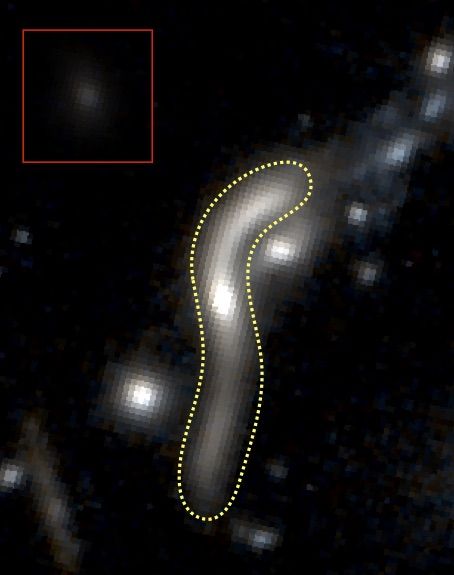
When conditions are just right, space can magically turn into a sort of magnifying glass, making even incredibly distant galaxies suddenly visible from here in the Milky Way. Now, the inherent power of the Hubble Space Telescope, combined with this trick, has let scientists stare at an incredibly faint corner of the universe they discover a new galaxy.
Astronomers identified the new galaxy as eMACSJ1341-QG-1, and, as they describe in a recent paper in The Astrophysical Journal Letters, it's not the first galaxy that has been discovered this way, but it's the most powerful example of the effect spotted so far for a galaxy so faint.
The magic trick behind the paper is called gravitational lensing, a well-known phenomenon for astronomers that is based on Einstein's theory of general relativity. Essentially, very massive objects and their tug of gravity bend space in their neighborhoods.
That means occasionally, the stars align. When a very massive galaxy comes smack in between Earth and a distant galaxy, the light from the distant galaxy is bent around the huge impediment. It turns out that makes it reach Earth much more effectively than it does when empty space comes between the two points. The end result is a much better look at a distant galaxy than we can get with technology alone.
Just how much better a view scientists can get of distant corners of the universe varies on the circumstances. In this case, the giant magnifying glass itself, a galaxy cluster called eMACSJ1341.9-2441, was already known to scientists, spotted in 2013 during a hunt for gigantic galaxy clusters. And it turns out that this particular cluster's gravitational lensing magnified eMACSJ1341-QG-1 by a factor of 30.
The team behind the research is still working on a paper that shares more of what they were able to learn about the newly discovered galaxy, but they do know it's full of relatively old stars and is no longer making new ones. That's not what scientists would have expected, since usually galaxies that are farther away are younger and still forming stars. That makes the galaxy itself a rare discovery and the magnifying glass an important tool for astronomers trying to decipher very distant corners of the universe.
Uncommon Knowledge
Newsweek is committed to challenging conventional wisdom and finding connections in the search for common ground.
Newsweek is committed to challenging conventional wisdom and finding connections in the search for common ground.
About the writer
Meghan Bartels is a science journalist based in New York City who covers the science happening on the surface of ... Read more
To read how Newsweek uses AI as a newsroom tool, Click here.








